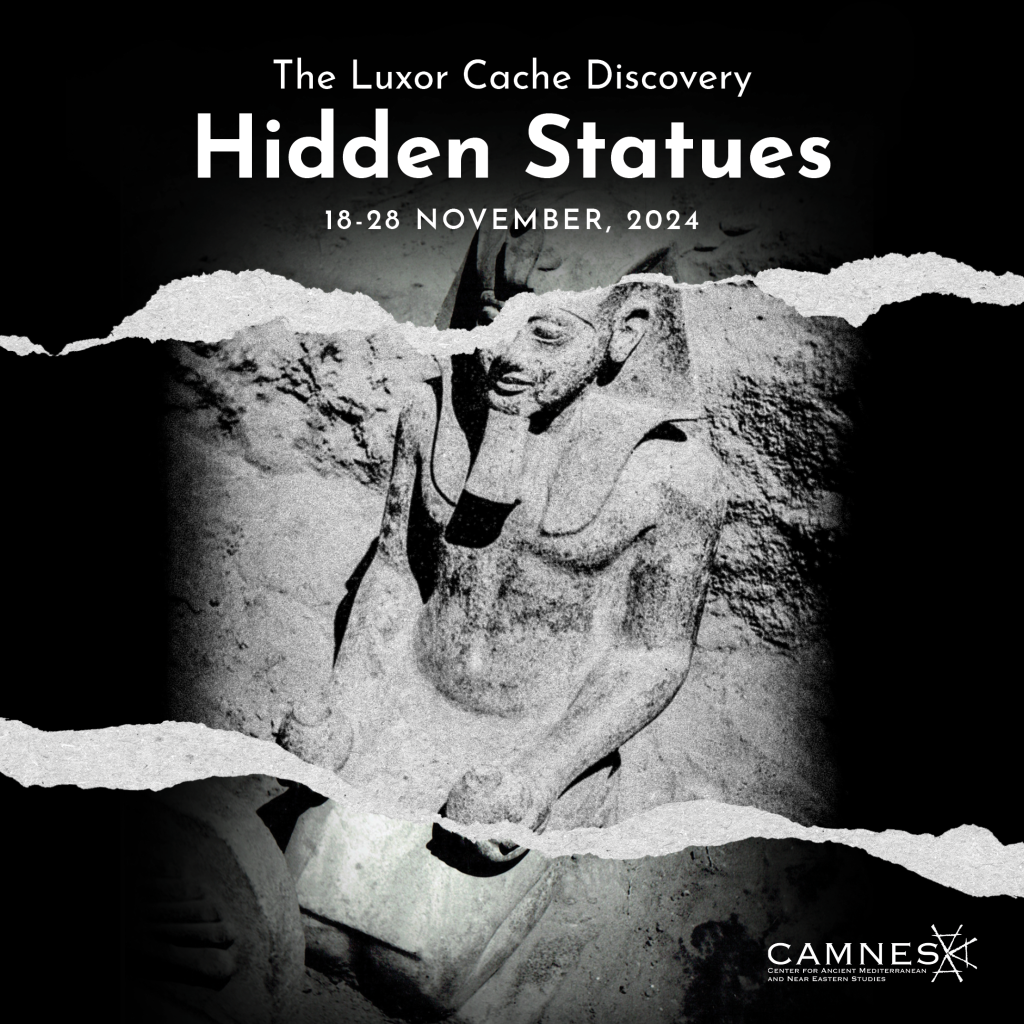Hidden Statues
The Luxor Cache Discovery
Curated by: Mostafa Al-Saghir, Massimiliano Franci, Irene Morfini, Valentina Santini.
Opening November 18th, from 10 AM to 1 PM
LdM Gallery, Via de’ Pucci 4
After the opening, the exhibition will stay open until
Thursday November 28th,
Mon & Tue & Fri 4-7PM, Wed-Thur 10AM-2PM

The Luxor Statue Cache, found by chance in 1989, is one of the 20th century’s most remarkable archaeological discoveries. This exhibition presents the adventure through photographs, including images of Dr. Mohammad Al-Saghir, the archaeologist overseeing the discovery.
On January 22, 1989, during routine cleaning at Luxor’s Amun temple, workers struck a stone base with a trowel, leading to the discovery of a statue base. Further excavation revealed a double statue pit, sparking interest in what might be hidden. The excavation, complicated by high underground water levels, unveiled 26 statues dating from the New Kingdom to the Ptolemaic Period.
Scholars are divided on the pit’s purpose: some believe it stored replaced statues, while others suggest priests buried them for protection during times of conflict. Alongside statues, pottery jars were also found. After recovery, the statues were stored and displayed in an underground Luxor Museum wing, replicating the cache environment.
The discovery, alongside the Avenue of the Sphinx, elevated Luxor’s significance, leading to its establishment as an independent governorate, separate from Qena. This find has enriched our understanding of Egyptian iconography and Luxor’s historic temple complex.
Mostafa Al-Saghir is the General Director of Karnak Temples and Avenue of Sphinxes at the Ministry of Tourism and Antiquities. He is the director of many archaeological missions in Luxor. He is a member of the International Association of Egyptologists and the American Alliance of Museums. He started his career as an Egyptologist and Archaeologist for more than 25 years. He was the head of many projects of excavation, restoration and development mainly in Luxor, such as projects of Deir El-Medina, Colossi of Memnon, Medinet Habu, Queens Valley and Qurnet Murei. During his work at the Minister’s scientific office, he created Luxor Pass and Cairo Pass. At Karnak, he qualified the temple to be accessible for the disabled as well as developing the signage and visitors’ services. He was the representative of the Ministry of Tourism and Antiquities on the project of Visual Identity of Luxor. He succeeded to complete the discovery of the Avenue of Sphinxes after 72 years of work and to make the official inauguration in November 2021.
Massimiliano Franci is an Associate Professor of Egyptology and Food Anthropology at CAMNES-LdM Institute. He was the secretary of the International Congress of Egyptologists, held in Florence in 2015. He participated in numerous international conferences and is the author of many scientific contributions, such as: “Rethinking Osiris (Rome 2021)” in collaboration with Salima Ikram (AUC) and Irene Morfini (CAMNES), and “The Stelae of Khentykhetjwn and the Ancient Egyptian Lexical Field of ‘The man, ages, and Kinship’: an invitation to an Anthropological Analysis (Cairo 2022)”. Among his recent projects is the development of new information technologies for the analysis of Egyptian artifacts in partnership with the CNR and the University of Florence.
Irene Morfini is an Egyptologist and Archaeologist. She graduated in Egyptology from both the University of Pisa in Italy and at the University of Leiden in the Netherlands. In 2019 she obtained her PhD at the University of Leiden. She’s participated in numerous excavations in Italy since 2000 and in Egypt since 2007. Since 2013 she has been co-director of the Min Project in Luxor. She has been vice-president of the Canarian Association of Egyptology who carries out research and dissemination of knowledge in the field of the archaeological, historical and scientific heritage of ancient Egypt and has been developing cultural projects in Egypt, Cuba and Ghana since 2011. Since 2017 she has been part of the staff of CAMNES. From 2019 till 2022 she has been working in the field for the EU-funded project ‘Transforming the Egyptian Museum in Cairo’, for the National Museum of Antiquities of Leiden and for the Museo Egizio of Turin.
Valentina Santini is currently pursuing her PhD in Egyptology at the University of Birmingham. From 2016 to 2018, she worked at the Museo Egizio in Turin, where, among other responsibilities, she focused on disseminating scientific and academic data to the wider public. She is a member of the Editorial Board of SANEM, the series of scientific publications of CAMNES, and serves as one of the Specialist Editors of the Rosetta Journal. Currently, she is actively involved in the Egypopcult Project funded by the Fundação para a Ciência e a Tecnologia (FCT). Valentina has authored numerous scientific papers and published books for a broad audience, including titles like ‘Butehamon: A scuola di scrittura nell’antico Egitto’ (Sillabe) and ‘I segreti di Tutankhamon: Storia di un faraone tra mito e realtà’ (Longanesi). Her primary scientific interests revolve around the Amarna Age and private funerary beliefs during the New Kingdom.
Gallery Supervisor: Špela Zidar
Intern: Catherine Amis, Gretta Lemke
LdM Gallery, Via de’Pucci 4 – Firenze
Opening: October 18, 10am-1pm
Duration November 18 to November 28
Opening hours Mon, Tue, Fri 4-7pm, Wed, Thu 10am-2pm
The LdM Gallery is a project by Istituto Lorenzo de’ Medici, an interdisciplinary space where academic research and artistic experimentation meet within a professional setting.